Second-Degree Burn Pictures
Different Types of Second-Degree Burns and their Healing Stages
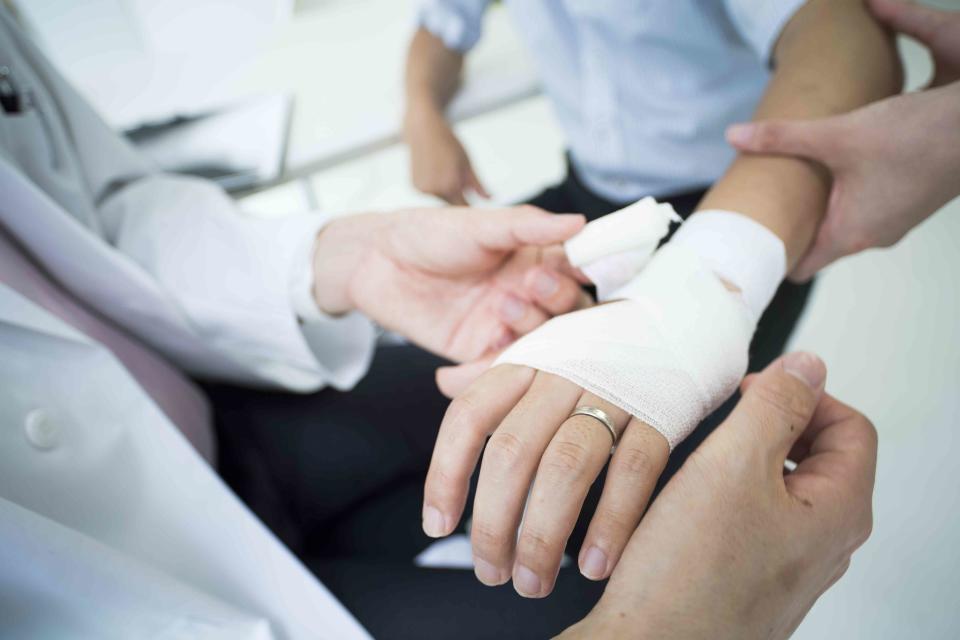
Medically reviewed by Michael Menna, DO
If you have a second-degree burn, run cool water over it for five to 30 minutes. Pat dry with a clean towel and cover with a bandage or non-stick gauze.
Second degree burns involve the outer layer of skin (epidermis) and can extend to the middle skin layer below (dermis). If your burn is more than 3-inches in diameter or covers a sensitive part of your body such as a joint, see a healthcare provider.
This article discusses the causes and treatment of second-degree burns. It also provides pictures of second-degree burns and their healing stages.
What Is a Second Degree Burn?
A second-degree burn is considered a mild to moderate injury. Its severity may vary depending on how large it is and whether it is on a sensitive part of the body.
The degree of a burn is based on how many layers deep the damage goes. First degree burns only damage the top layer of skin, called the epidermis. Second-degree burns damage the epidermis and the second layer of skin, called the dermis. Third-degree burns damage the epidermis, dermis, and fatty tissues under the skin.
SEVERITY | EPIDERMIS | DERMIS | SUBCUTANEOUS |
1st-degree burn | ✓ |
| |
2nd-degree burn | ✓ | ✓ | |
3rd-degree burn | ✓ | ✓ | ✓ |
A 2nd-degree burn that affects less than 10% of the skin's surface can usually be treated on an outpatient basis using antibiotic ointments. The sterile dressing will need to be changed two or three times a day, depending on the severity of the burn. Larger burns need medical attention.
Related: How Different Degrees of Burns Are Treated
What are the Second-Degree Burn Healing Stages?
Burns heal in three stages. Your second-degree burn will look different during each of the three healing stages.
Inflammatory (reactive). During the first stage of healing, your immune system sends white blood cells to the injury. This helps prevent infection, remove dead tissue, and activate damage repair. During this stage, you will experience swelling and discoloration at the burn site.
Proliferative (reparative). During the second stage of healing, the wound begins to close and damaged blood vessels are repaired. During this stage, the damaged skin may flake or peel as your body gets rid of it. The proliferative stage overlaps with the inflammatory stage.
Maturation (remodeling). During the third stage of healing, your body deposits collagen and elastin into the damaged tissue to help build scar tissue. This stage determines what the healed area will look like and how much visible scar tissue will be present. The maturation stage overlaps with the proliferative stage.
You will know your burn is healing right if it is progressing through these stages and there are no signs of infection. Burns that have red streaks or purple discoloration with significant swelling may be infected. The presence of pus and/or a fever are also signs that your burn is not healing correctly.
How Long Will it Take To Heal?
It may take between one and three weeks for your second-degree burn to heal. Healing time varies depending on how large your burn is, what caused it, and what part of your body it's on.
Will I Have a Scar?
Second-degree burns can cause scarring, but not always. Larger, more severe burns are more likely to scar.
Even if you don't have a scar, you may notice that your skin becomes lighter or darker in the area where the burn occured. This type of discoloration may fade a little over time, but tends to be permanent.
What Do Second-Degree Burns Look Like?
Second-degree burns can look different depending on their cause, size, and exact depth.
The pictures below will show you some of the different causes of second-degree burns and what they look like.
Scalding
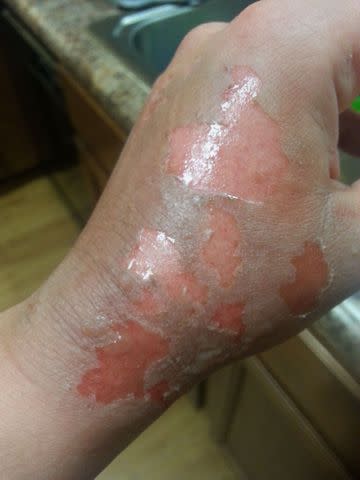
Nordyke
This second-degree burn was caused by scalding with hot water. The woman involved was carrying a pot of boiling water and lost her grip on one handle. The water spilled on her left hand.
Scalds are burns from hot liquids. They almost never cause full-thickness (third-degree) burns, but they do blister quickly.
According to the Centers for Disease Control and Prevention (CDC), over 350,000 Americans are treated for burns in emergency rooms each year. Over 40,000 are hospitalized.
Open Flame Burn
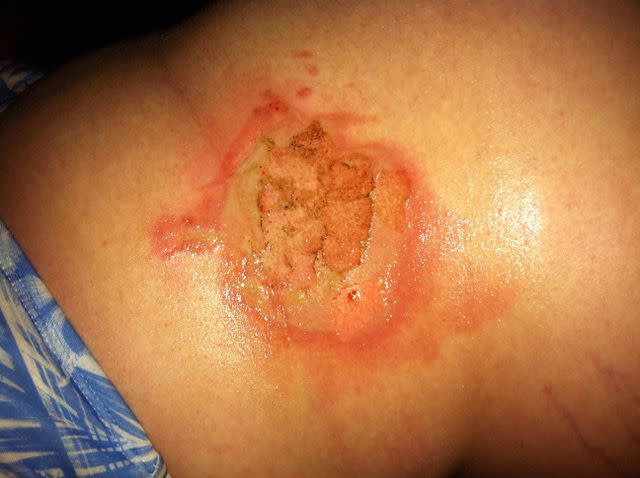
Shells
An unloaded potato gun gave this person a second-degree burn. A potato gun uses hairspray as the explosive agent to shoot a potato into the air. In this case, the flaming hairspray damaged the skin.
Symptoms of a second-degree burn include pain, deep redness, blistering, and areas of exposed tissue that are moist and shiny.
Chemical Heat Pack Burn
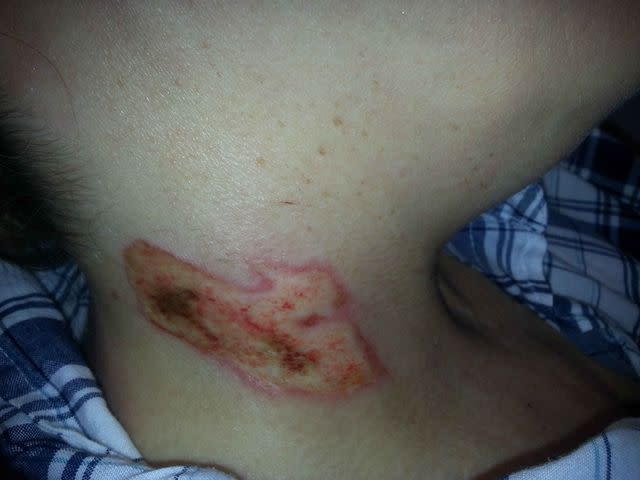
Nise
A reusable chemical heat pack burned this person's neck. The person microwaved the pack for 60 seconds, even though the instructions said to heat it for 30 seconds.
There are no blisters here. Blisters show that the epidermis is damaged but not destroyed. In this case, the destruction of the outer layer caused areas of whiteness and discoloration common with many second-degree burns.
Chemical Heat Pack Burn (Five Weeks Later)
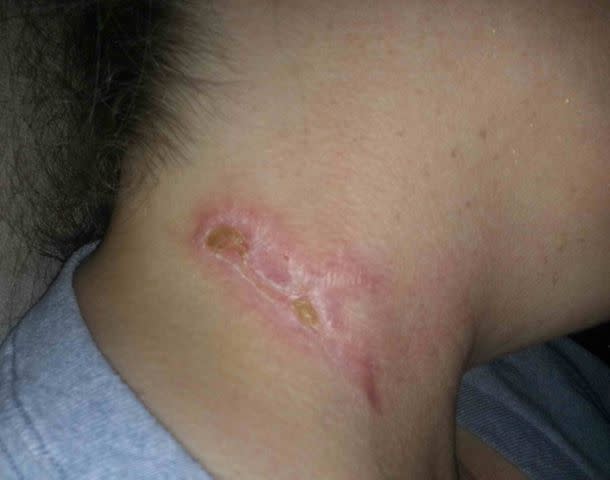
Nise
After a burn from a chemical heat pack, this person was treated with topical anesthetics to numb the skin. This picture shows how the burn looks five weeks after the injury.
Even after significant healing, burns this severe can cause pain for weeks. Over-the-counter pain relievers like Tylenol (acetaminophen) can help.
Related: Chemical and Acid Burns
Candle Wax Burn
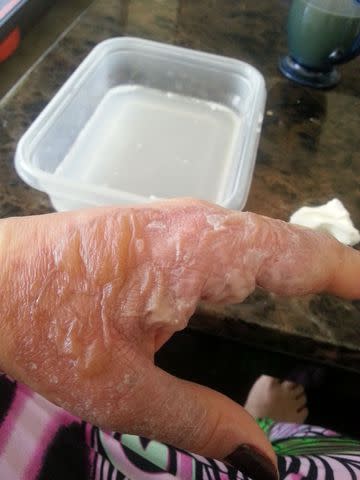
Cmoore
Hot candle wax is a common cause of second-degree burns. In this case, the candle wax exploded and splattered wax onto the person's hand.
When water touches hot wax near a burning wick, the wax can explode. The type of candle or wax can make a big difference in how severe the injury is.
Paraffin wax melts at around 120 degrees F. Votive candles melt at around 135 F, and taper candles at 140 F or higher. The most serious burns come from beeswax, which melts at 145 F or higher.
To avoid burns, the wax temperature should be well below 125 F. That's a common temperature for body waxing.
Steam Iron Burn
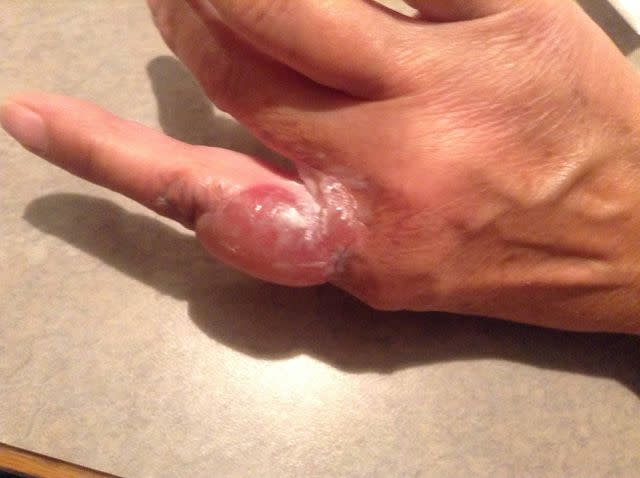
Cheryl H.
After burning herself with the steam from a household iron, this woman developed a painful second-degree blister on her pinky finger.
It's easy to underestimate the dangers of hot steam. When your car overheats, for example, the steam escaping from the radiator will be between 190 F and 220 F. That's hot enough to cause a severe burn in less than a second.
If the jet of hot steam hits your eye, your cornea can be severely damaged. Burns like this can cause:
Scarring
Holes in the eye tissue
Blindness
What Is the Fluid in a Burn Blister?
The fluid inside a burn blister is ultrafiltration of plasma. It is rich in immunoglobulins, cytokines, prostaglandins, and interleukins. This may help the burn to heal faster.
Learn More: Steam Burns and How to Prevent Them
Hot Oil Burn
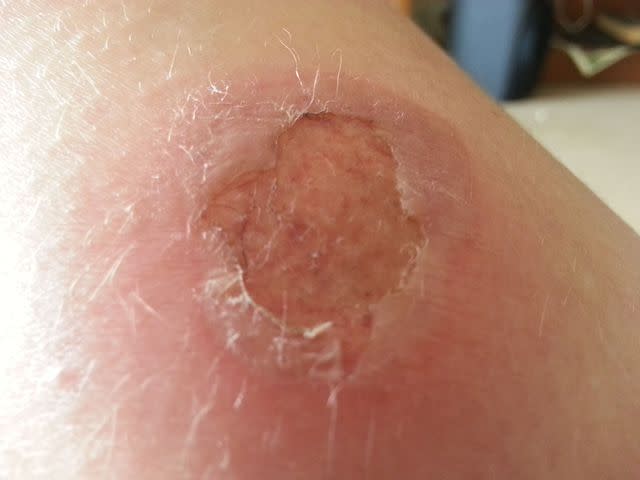
Sarah
Hot oil burns are common in the kitchen, especially among children. Deep fryers are often the culprits. When water spills or splashes into a deep fryer, there's a huge splatter. Fat splattering from a hot frying pan can also cause burns. In this case, hot oil from a campfire frying pan damaged someone's knee.
Cooking oil can easily exceed 375 F, but it is not the only source of non-water liquid burns. Motor oil can reach 275 F. You can be injured if you try to change the oil too soon after a car engine has stopped running. Even worse is molten sugar used for making candy. It can easily exceed 340 F.
Related: How to Safely Put Out a Grease Fire
Sunburn
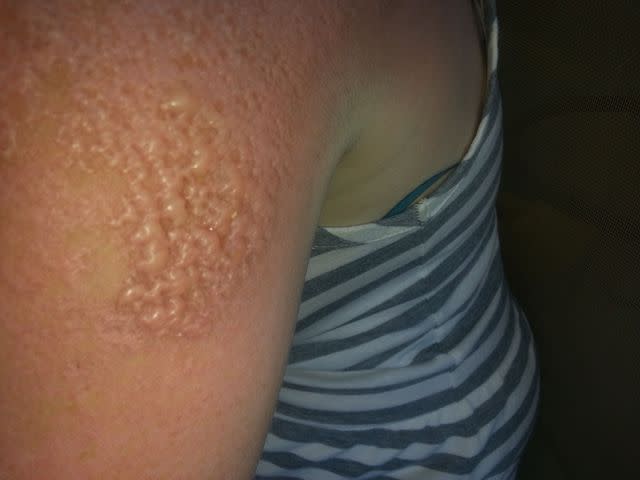
Jayjay
Sunburns usually cause redness, stinging, and peeling. However, if you stay out long enough or fall asleep in the sun without UV protection, you can easily get a severe second-degree burn.
The problem with second-degree sunburns is that large areas of skin are involved. The blistering can be extensive and can cause terrible pain.
Because such large areas are involved, you may also experience:
Rapid dehydration
Fever
Chills
Weakness
Higher likelihood of infection
In rare cases, people with sunburn can go into shock.
A second-degree sunburn takes longer to heal than a first-degree sunburn. Your skin may still be discolored after you've healed and your scars may be permanent.
Learn More: How to Treat a Sunburn
Second-degree sunburns increase the lifetime risk of developing skin cancer, including melanoma.
Friction Burn
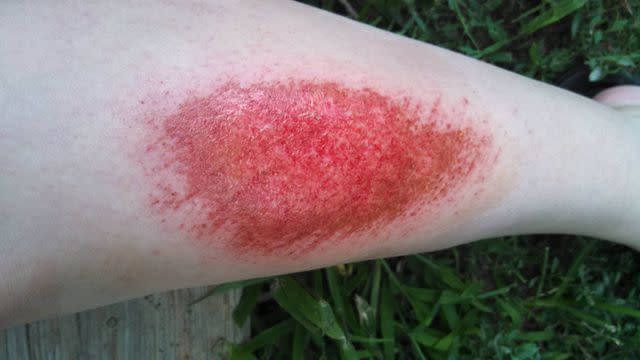
Dawn H.
A friction burn is a type of abrasion or scrape. It causes the loss of the epidermis and damages the dermis below. Friction burns don't involve heat, but they are still considered second-degree burns.
They're treated in the same way as a thermal (heat) burn. The most common types of friction burn are road rash and rug burns.
Topical antibiotic ointments and twice-daily dressing changes can usually prevent infection. Oral antibiotics may be prescribed for more severe cases.
Sloughing
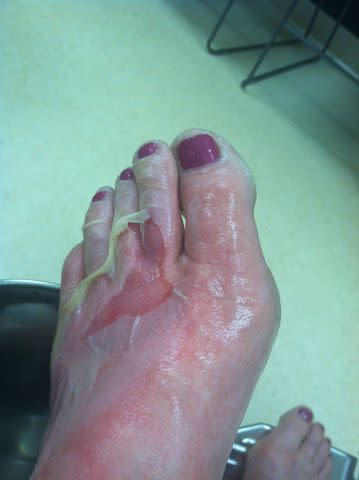
Shelley Saunders
Once a second-degree blister pops or tears, the epidermis will begin to fall away in sheets. This normal process is called sloughing. This photo shows sloughing after someone spilled hot water from a pot of pasta onto her foot.
Sloughing may start several days after the injury. When skin sloughs after a severe burn, the exposed tissue may not have begun to heal. In such cases, oral antibiotics may be needed to reduce the risk of infection.
How to Treat a Second-Degree Burn
The first thing you should do for a second-degree burn is cool the skin to keep the burn from getting worse. You can do this by:
Running cool water over it
Putting the burned area in a container of cool water
Applying a cool compress
Continue cooling the skin until it no longer hurts when you remove the source of the cold. It may take as long as 30 minutes.
No Ice!
Don't use ice or ice water to cool your skin after a burn. Temperatures that are too low can further damage the tissues.
Treatments for a second-degree burn may include:
Antibiotic cream, over-the-counter or prescription
Bandaging with gauze or something else that won't stick to the burn
Over-the-counter pain medication such as Tylenol (acetaminophen) or Advil (ibuprofen)
Elevation to prevent inflammation and lessen pain
Burns heal better when they are covered. Change the dressing within 48 hours after the wound is first bandaged. If it's healing well after that, change the dressing every three to five days. However, if the burn area is painful or there's an odor, change the bandages right away.
When to See a Healthcare Provider
Get medical attention for a second-degree burn if:
The burn is blistered
You have severe pain
You develop a fever or other signs of infection
The burn doesn't improve in two weeks
Fluid is leaking from the burned area
Swelling or redness increase
The burn is more than 2-3 inches wide
The burn is on the hands, feet, face, genitals, buttocks, or over a major joint
Preventing Second-Degree Burns
Second-degree burns and all other types of burns can be prevented with simple precautions. For example:
Don't touch surfaces that are hot or may be hot
Keep your hot water heater turned down
Wear sunscreen if you're going to spend time outdoors
Wear gloves and protective gear when working around fire or chemicals
Don't get close to open flames, especially when wearing loose clothing
Don't let children near hot objects such as pots and pans and make sure their food has cooled to a safe temperature before giving it to them
Summary
Second-degree burns damage the top layer of skin (epidermis) and the second layer of skin (dermis). Fire, chemical heat packs, and hot liquids can cause burns like these. So can friction and sunburn.
If you've had a second-degree burn, you can expect to have pain, redness, blistering, and sloughing of the top layers of skin as you heal. You may have some scarring and your skin may be a different color after the burn heals.
You may be able to treat a second-degree burn with cool water, antibiotic creams, pain relievers, and clean bandages. If your burn is more severe, you should seek medical care right away.

